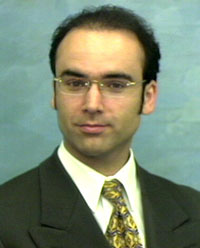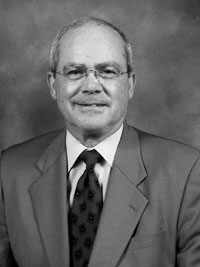 |
Ali Khoynezhad, M.D., Ph.D. |
 |
Thomas Howard, M.D. |
“I knew from what the surgeons told me that it was rare to be awake during this type of surgery,” said the 50-year-old from Dannebrog, Neb. “So, that made me want to concentrate all the more on what my doctors were saying.”
Commonly during an endovascular thoracic aortic aneurysm repair, the patient is put under with general anesthesia. Not for Bowers surgery on Oct. 9 — during which only local anesthesia was used.
“I was told going into the surgery that I was in a way like a guinea pig,” Bowers said. “Now my surgery is making headlines.”
Medical reports indicate this is the first time in the Midwest that a thoracic aortic aneurysm repair has been performed with only local anesthesia.
Ali Khoynezhad, M.D., Ph.D., assistant professor of cardiovascular and thoracic surgery at UNMC and cardiothoracic and endovascular surgeon at The Nebraska Medical Center, performed the surgery with assistance from Thomas Howard, M.D., clinical associate professor at UNMC and senior vascular surgeon at The Nebraska Medical Center.
At University of California, Los Angeles, where Dr. Khoynezhad received his training, 85 percent of endovascular aneurysm repairs are performed without general anesthesia. Dr. Khoynezhad knew it could be done and Bowers was the perfect patient.
“The day before he had his first surgery for repair of one of two of his aneurysms, he was put under with general anesthesia and had difficulty waking up,” Dr. Khoynezhad said. “We didn’t want to put Dwight through that again. Plus, Dwight said he had to return to work as soon as possible. Foregoing the use of general anesthesia can shorten a hospital stay significantly, and accelerate the recovery time.”
Dr. Khoynezhad added that the use of local anesthesia versus general anesthesia has many other benefits.
“Risks unique to general anesthesia like vocal cord injury, sore throat and muscle pain are eliminated,” he said. “More importantly, the patient’s collaboration during the procedure can also help reduce potential serious complications.”
One day after the surgery, Bowers was on his way home and less than two weeks after surgery, Bowers returned to work.
“If the surgery had been performed under general anesthesia, Bowers would have had a four-day hospital stay and a longer recovery at home before being able to return to work,” Dr. Khoynezhad said.
Endovascular repair is a relatively new procedure for the treatment of thoracic aortic aneurysms.
In May 2005, the procedure was approved by the Food and Drug Administration. Dr. Khoynezhad and his team performed Omaha’s first endovascular repair on April 14, 2006.
The minimally invasive approach involves making an incision in the groin. A catheter is inserted into the leg arteries. Dr. Khoynezhad and his team then carefully guide the catheter, which carries a small endovascular graft, through the abdomen and into the chest. Once positioned inside the affected part of the aorta, the endovascular graft is released and gently expands to become a perfect fit.
The graft remains in the aorta permanently, preventing blood flow to the aneurysm. The procedure takes about two hours making it shorter than traditional, open surgery — which requires a large chest incision and at least four hours operating time.
“In a selected patient population and in the hand of an experienced surgeon, endovascular repair for thoracic aortic aneurysm has much lower morbidity and mortality compared to the patients undergoing open repair,” Dr. Khoynezhad said.
Other benefits include significantly lower blood loss during the operation and shorter recovery time.
“Clearly, the technical advances that made this surgery possible represent a major step forward in the improvement of care for patients in our region with aortic disease,” Dr. Howard said.
Thoracic aortic aneurysms are diagnosed in approximately 40,000 people each year, but the actual number of those affected may be much higher. Aortic disease is the 13th leading cause of death in the United States, killing more than 43,000 people a year. Many times the condition goes undiagnosed due to a lack of symptoms.
It is a coincidence that Bowers’ aneurysms were detected. In August, Bowers had a polyp on his throat removed, that’s when a CT scan showed the aneurysms.
“I was on my way home from my pre-surgery consultation for throat surgery when I got a call from my doctor’s office in Grand Island and they said to head to The Nebraska Medical Center,” Bowers said.
At The Nebraska Medical Center, it was determined that Bowers had two pseudo-aneurysms at the top portion of his thoracic aorta.
“He is a lucky man,” Dr. Khoynezhad said. “Pseudo-aneurysms are the dangerous type of aneurysms because they’re more prone to rupture (burst) due to an unusually thin aortic wall. Dwight’s job requires him to lift heavy objects. Heavy lifting can cause blood pressure to escalate, which puts him at high risk for a rupture of the already weakened aortic wall. A rupture will cause a life-threatening hemorrhage (uncontrolled bleeding) and potentially death.”
“I call my throat problem a blessing in disguise,” Bowers said. “I got a second chance. It makes me thankful.”
Risk factors for thoracic aortic aneurysms include diabetes, heart disease, smoking, high blood pressure, chronic obstructive lung disease and a family history of aneurysms or connective tissue disorder.
The Nebraska Medical Center is one of three hospitals in the state currently offering minimally invasive endovascular repair. The endovascular specialists at The Nebraska Medical Center have performed more endovascular repairs than any other center in the surrounding states. To date, there are no other reports of endovascular repair under local anesthesia in the Midwest.
In August, The Nebraska Medical Center opened a vascular center, the only one of its kind in the region dedicated to the diagnosis, treatment and management of diseases of the circulatory system, bringing together experienced specialists from cardiology, interventional radiology, vascular surgery and cardiothoracic surgery to share their skills in vascular care.
“Our patients are receiving more comprehensive and efficient care and our specialists are more accessible,” Dr. Howard said. “The vascular center also helps us improve follow-up and long-term care.”